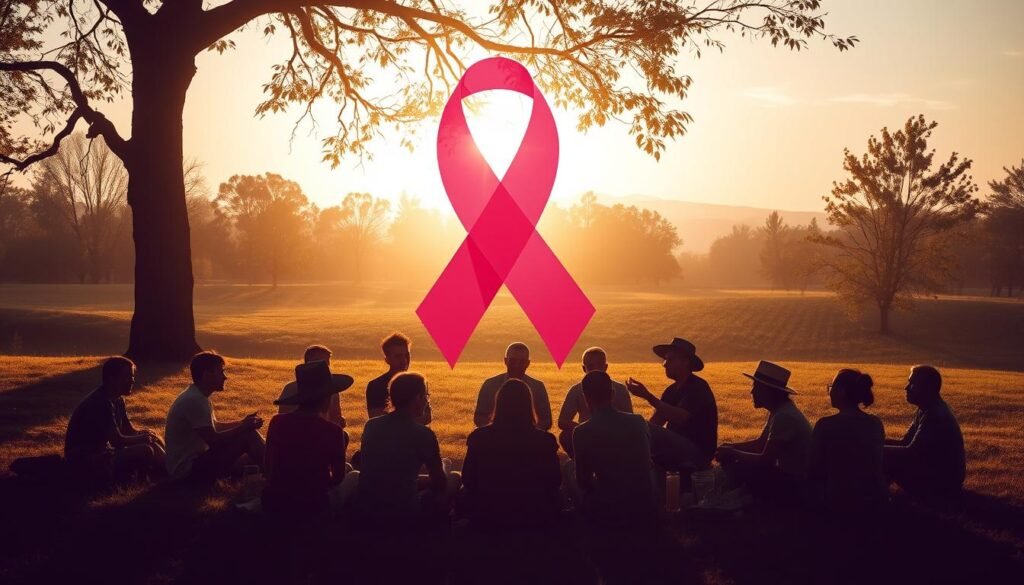In 2022, the United States saw 236,740 new lung cancer cases. This disease is the top cause of cancer deaths, with 130,180 lives lost. These numbers highlight the critical need for more awareness and support for lung cancer. The ribbon stands as a symbol of unity with those affected. It also pushes for vital research and help.
By wearing this ribbon, we start important discussions on lung cancer. It helps fight the stigma and stresses the importance of early detection and treatment. Understanding what this ribbon stands for encourages us all to take part. It shows that beating this disease needs help from everyone and changes in our system.
Key Takeaways
- The lung cancer awareness ribbon symbolizes support for lung cancer patients and families.
- Lung cancer accounts for the highest number of cancer-related deaths in the U.S.
- Understanding the significance of the lung cancer ribbon is crucial for raising awareness.
- Advocating for lung cancer involves community support and funding for research.
- Over half of lung cancer diagnoses are among former smokers or non-smokers.
- The evolution of awareness ribbons has historical significance dating back to the Middle Ages.
The Significance of the Lung Cancer Ribbon
The lung cancer ribbon symbolizes unity and strength. It shows the struggles of patients and the value of community support. Groups like the American Lung Association and the White Ribbon Project offer crucial help. They improve lung health and support families.
Wearing this ribbon helps fight lung cancer awareness. It starts important talks. These conversations can lessen the loneliness and shame linked to the disease.
Supporting Patients and Families
Many with lung cancer feel judged because people often link the disease to smoking. This judgment affects their emotional health. It shows why we need caring and understanding from healthcare workers. The White Ribbon Project works to change how people see lung cancer. They stress empathy and inclusion for patients.
Cancer’s impact is deep. Yet, strong cancer support efforts can create a positive environment for those impacted.
Raising Awareness About Lung Cancer
Educating people on lung cancer’s symptoms and early detection is crucial. Lung cancer is the top cause of cancer deaths in the United States. Still, many campaigns focus on risk factors and how to prevent the disease. Wearing the ribbon shows support and sparks vital discussions.
This advocacy encourages better screening and health in communities. It helps empower others and spread knowledge about lung cancer. The goal is fairer care for everyone affected.
The Symbolism Behind the Lung Cancer Ribbon
The lung cancer ribbon is a powerful symbol for those touched by this illness. It mainly appears in white or pearl, signaling hope, strength, and unity. Besides white, other colors are also used by some organizations to stand out and get noticed by more people.
Colors Used for the Lung Cancer Ribbon
White and pearl are the main colors for lung cancer awareness. They show innocence and the fight against this disease. It tells us that lung cancer can affect anyone, no matter how they live. The idea to use different ribbon colors started in the 1990s. It followed the steps of campaigns for HIV/AIDS and breast cancer awareness. This movement helped people understand and support the fight against various cancers.
Differences Among Cancer Ribbons
Every cancer has its unique ribbon color, which is key for spreading awareness. Here’s a table with some cancer ribbons and their colors:
| Cancer Type | Ribbon Color | Symbolism |
|---|---|---|
| Lung Cancer | White/Pearl | Hope and solidarity |
| Breast Cancer | Pink | Awareness and support |
| Prostate Cancer | Light Blue | Advocacy and education |
| Colon Cancer | Dark Blue | Awareness and prevention |
| Ovarian Cancer | Teal | Support in treatment |
Wearing the lung cancer ribbon helps raise awareness and pays tribute to those affected. Taking part in Lung Cancer Awareness Month in November boosts community involvement. It also encourages talks about the importance of support and funding for research. These conversations are vital because lung cancer causes many cancer deaths worldwide. For more on lung cancer, check out TNM staging system.
History of the Lung Cancer Awareness Ribbon
The journey of the lung cancer awareness ribbon is inspiring. It shows the progress in fighting this illness. It all started from humble beginnings, moving on to become a strong symbol in cancer advocacy. Now, it tells a powerful story.
These ribbons are more than just fabric. They symbolize the battles of patients and their families. They also push for early disease detection and prevention. The ribbons unite us in the fight against lung cancer.
The Evolution of Awareness Ribbons
Over the years, awareness ribbons have changed a lot. They started as symbols for various causes. But now, they focus mainly on cancer awareness. The white, pearl, or clear ribbons stand for lung cancer.
They bring hope and symbolize purity. Among other cancer ribbons, they remind us that we’re all in this fight together. They highlight the common goal of cancer advocacy.
Key Events in Lung Cancer Awareness History
Lung Cancer Awareness Month is in November. It helps educate people about the disease. It’s also a time to support those affected by it.
The White Ribbon Project plays a big role. It was started by lung cancer survivors. They work hard to increase awareness and raise funds. Their goal is to honor those affected and build supportive communities.
Lung Cancer by the Numbers
Lung cancer stats are both significant and alarming. They show how vital lung cancer awareness is. The American Cancer Society predicts that 234,580 people will be diagnosed with lung or bronchus cancer in 2024 in the U.S. This number highlights the battle ahead in fighting this widespread disease.
Statistics and Trends in the U.S.
The figures on lung cancer are quite bleak. In the U.S., over 400,000 people are currently fighting lung cancer. The average age of these patients is 70, and about 80% are over 60. It’s alarming that deaths among women from lung cancer have increased by 150% in two decades. Men saw a 20% increase in the same timeframe. Plus, about 85% of lung cancer patients were smokers, showing how smoking is a huge risk factor.
| Statistic | Value |
|---|---|
| Total lung cancer diagnoses (2024) | 234,580 |
| New cases in 2020 | 228,820 |
| Percentage of deaths among women (last 20 years) | 150% |
| Percentage of deaths among men (last 20 years) | 20% |
| Average cost of lung cancer treatment (first six months) | $79,818 |
| Current lung cancer patients with a history of tobacco | 85% |
| Percentage of full recovery | 17% |
Global Impact of Lung Cancer
Lung cancer is a top killer worldwide, with second-hand smoke causing about 600,000 deaths yearly. In 2018, the world saw over 2.1 million new cases. Most of these were in developing countries. These numbers underline the need for global lung cancer awareness. Second-hand smoke increases cancer risk by 30%. We must focus on educating and preventing to tackle these worrying trends.
Key Campaigns and Initiatives for Lung Cancer Awareness
Lung cancer campaigns and initiatives are crucial. They teach the public and support those struggling with lung cancer. Lung Cancer Awareness Month in November is key for raising awareness and pushing for early detection.
Lung Cancer Awareness Month
During this month, many events take place to draw attention to lung cancer. They teach people about risks, the need for early discovery, and treatment choices. Here are some awareness activities:
- Public screenings and educational seminars
- Fundraising events to support research
- Social media campaigns to spread information widely
- Partnerships with local health organizations to maximize outreach
Notable Lung Cancer Organizations
Several groups focus on cancer advocacy, aiding lung cancer patients and their families. Highlighted organizations are:
| Organization | Focus | Initiatives |
|---|---|---|
| GO2 Foundation for Lung Cancer | Research Funding | Patient support programs, outreach efforts, and lung cancer education |
| Dusty Joy Foundation | Patient Services | Direct assistance to patients and funding for lung cancer research |
| American Lung Association | Lung Health Awareness | Lung disease research, prevention programs, and advocacy |
These groups work hard to engage communities and improve cancer advocacy. They support vital resources and push for better treatments and research, helping lung cancer patients significantly.
Understanding Lung Cancer Stigma
Lung cancer stigma often leads to discrimination and misunderstanding. It mainly comes from linking lung cancer with smoking. Many people don’t know that over half diagnosed are non-smokers or former smokers. These wrong beliefs delay vital diagnoses and lessen the support from the cancer community. Teaching and raising awareness are key to reducing stigma among various groups.
Common Misconceptions
Even with more awareness, many myths about lung cancer still exist. Some think only smokers get lung cancer, ignoring genetics and the environment. Many are unaware that lung cancer is the deadliest cancer in the US. It takes more lives than breast, prostate, and colon cancers combined. This belief causes deep shame in patients, making them reluctant to get treatment or talk about their condition.
The Role of the Ribbon in Overcoming Stigma
The lung cancer ribbon is crucial in fighting stigma. It helps increase awareness, build empathy, and boost community support. Groups like the GO2 Foundation and LUNGevity use this symbol to support lung cancer patients. They share personal stories and fight against wrong beliefs, improving understanding. People can also join the lung cancer community, helping lessen stigma and strengthen emotional support. Learn more about fighting lung cancer stigma by sharing personal tales and through education.

Advocacy Through the Lung Cancer Ribbon
The lung cancer ribbon does more than just stand for a color. It symbolizes a movement that builds community support and boosts cancer advocacy. This symbol helps fight the stigma attached to the disease. It also improves awareness efforts by promoting research funding.
Encouraging Donations and Research Funding
The effort to support lung cancer uses the ribbon’s power to inspire donations for important research. Lung cancer is the top cancer killer but gets less funding than other cancers. Groups like the White Ribbon Project aim to change that.
They work hard to focus more attention and money on lung cancer. They believe more funding can lead to advances in prevention and treatment. This makes it easier to find the disease early in those at risk.
Community Involvement and Support
Getting the local community involved is key to raising lung cancer awareness. Events and educational sessions invite people to join in and support each other. The White Ribbon Project has made white wooden ribbons a sign of hope and unity.
They offer a place for lung cancer stories from survivors and fighters to be told. This helps connect people from various walks of life. Having well-known people, like Chris Draft, take part shows how important it is to come together.
Lung Cancer Health and Treatment Options
Spotting early signs and symptoms can make a big difference for those at risk of lung cancer. Knowing these signs early can lead to timely treatment, possibly saving lives. Look out for symptoms like:
- Persistent cough that doesn’t go away
- Shortness of breath or wheezing
- Unexplained weight loss
- Chest pain that gets worse with deep breaths or coughing
Signs and Symptoms to Recognize
It’s crucial to keep an eye on lung health, especially for those with a smoking history or exposure to harmful substances. These factors heighten lung cancer risk, highlighting the importance of recognizing symptoms.
Current Treatment Advances
Recently, lung cancer treatments have seen significant advances. Nowadays, targeted therapies and immunotherapy lead the way, showing great results in patient care. Also, newer low-dose CT scans improve lung cancer detection, important for high-risk groups like veterans.
With close to 8,000 veterans diagnosed each year, early screening is key.

Talking about the latest treatments helps us understand them better. It also encourages people to support lung cancer research and care efforts.
How to Get Involved
Getting involved in lung cancer awareness can be very rewarding. By taking part in community events, you help raise awareness and create bonds with others affected by lung cancer. This involvement is key to building support networks and improving education about the disease.
Participating in Awareness Events
Groups like LUNGevity organize events for people touched by lung cancer. By volunteering or going to these events, you can share your story and help spread awareness. Special events, such as the Carolina Hurricane’s Hockey Fights Cancer Night or the All-In to Fight Cancer Poker Tournament, let supporters come together to fundraise for research and patient support. Being active on social media as a Social Media Ambassador also helps increase awareness.
Supporting Lung Cancer Charities
Supporting charities like the American Lung Association helps boost research funds and patient care. You can make tax-deductible donations, and some companies will match your gift. Setting up monthly donations offers ongoing support for these important efforts. Online communities also offer critical support, connecting patients and caregivers in meaningful ways.
| Involvement Type | Description |
|---|---|
| Awareness Events | Participate in community gatherings to raise awareness and share personal experiences. |
| Financial Contributions | Donate to organizations focusing on lung cancer research and support. |
| Volunteer Opportunities | Help organize events or start DIY fundraisers to collect donations. |
| Online Support | Join online forums and support groups that connect individuals affected by lung cancer. |
| Employer Matching | Check if your company matches charitable contributions to amplify your donation. |
Sharing Personal Stories
Stories about lung cancer deeply touch patients and their families. Patient stories show the hard challenges they face. They help everyone else feel more empathy and connection, stressing the importance of cancer support and awareness.
Understanding the Patient Perspective
Every person’s story is a mix of hard times and victories, showing how tough lung cancer is. For example, Misty felt better soon after finding out she was sick, but others have a harder time. Sharing stories makes people feel less alone. It helps them connect over shared hardships and triumphs, which is key for feeling okay emotionally.
Building Community Support Networks
Community support networks are super important. They let patients share experiences and learn from each other. They offer key help for dealing with treatment and staying strong mentally. Many stories talk about how crucial these groups are for emotional and mental health.

Talking more about lung cancer is vital. We need ongoing research and money to help patients and raise awareness. Personal stories make it real for people who don’t know much about lung cancer. They help build supportive communities. When patients share their stories, they fight against stigma and aim to make life better for those touched by lung cancer.
For more moving stories, see personal stories of lung cancer patients. These highlight the strength and hope within the cancer community.
Conclusion
The lung cancer awareness ribbon is not just a symbol. It’s a call for action, support, and teaching. It brings together patients, their families, healthcare workers, and advocates. Together, they fight lung cancer, which takes more lives each year than breast, colon, and prostate cancers combined. Talking about lung cancer is vital to break the stigma linked to it.
Many think lung cancer is only a smoker’s disease, which is not true. Non-smokers can get it too. Supporting cancer projects helps with donations and fundraising. These efforts boost research and better treatments. Charity events with the lung cancer ribbon bring people together and show unity.
Raising awareness for lung cancer is key to helping patients do better. When we all push for more funds and awareness, we help those affected by lung cancer. This makes our community more caring and informed, moving us towards a better future.